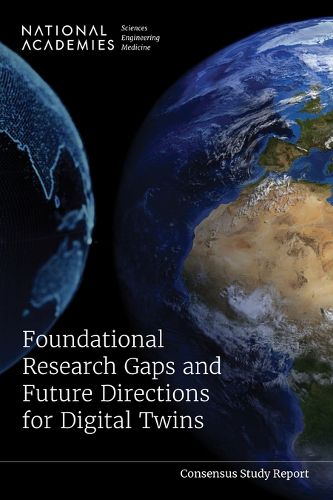Readings Newsletter
Become a Readings Member to make your shopping experience even easier.
Sign in or sign up for free!
You’re not far away from qualifying for FREE standard shipping within Australia
You’ve qualified for FREE standard shipping within Australia
The cart is loading…






Across multiple domains of science, engineering, and medicine, excitement is growing about the potential of digital twins to transform scientific research, industrial practices, and many aspects of daily life. A digital twin couples computational models with a physical counterpart to create a system that is dynamically updated through bidirectional data flows as conditions change. Going beyond traditional simulation and modeling, digital twins could enable improved medical decision-making at the individual patient level, predictions of future weather and climate conditions over longer timescales, and safer, more efficient engineering processes. However, many challenges remain before these applications can be realized.
This report identifies the foundational research and resources needed to support the development of digital twin technologies. The report presents critical future research priorities and an interdisciplinary research agenda for the field, including how federal agencies and researchers across domains can best collaborate.
Table of Contents
Front Matter Summary 1 Introduction 2 The Digital Twin Landscape 3 Virtual Representation: Foundational Research Needs and Opportunities 4 The Physical Counterpart: Foundational Research Needs and Opportunities 5 Feedback Flow from Physical to Virtual: Foundational Research Needs and Opportunities 6 Feedback Flow from Virtual to Physical: Foundational Research Needs and Opportunities 7 Toward Scalable and Sustainable Digital Twins 8 Summary of Findings, Conclusions, and Recommendations Appendixes Appendix A: Statement of Task Appendix B: Workshop Agendas Appendix C: Opportunities and Challenges for Digital Twins in Atmospheric and Climate Sciences: Proceedings of a Workshop-in Brief Appendix D: Opportunities and Challenges for Digital Twins in Biomedical Research: Proceedings of a Workshop-in Brief Appendix E: Opportunities and Challenges for Digital Twins in Engineering: Proceedings of a Workshop-in Brief Appendix F: Committee Member Biographical Information Appendix G: Acronyms and Abbreviations
$9.00 standard shipping within Australia
FREE standard shipping within Australia for orders over $100.00
Express & International shipping calculated at checkout
Across multiple domains of science, engineering, and medicine, excitement is growing about the potential of digital twins to transform scientific research, industrial practices, and many aspects of daily life. A digital twin couples computational models with a physical counterpart to create a system that is dynamically updated through bidirectional data flows as conditions change. Going beyond traditional simulation and modeling, digital twins could enable improved medical decision-making at the individual patient level, predictions of future weather and climate conditions over longer timescales, and safer, more efficient engineering processes. However, many challenges remain before these applications can be realized.
This report identifies the foundational research and resources needed to support the development of digital twin technologies. The report presents critical future research priorities and an interdisciplinary research agenda for the field, including how federal agencies and researchers across domains can best collaborate.
Table of Contents
Front Matter Summary 1 Introduction 2 The Digital Twin Landscape 3 Virtual Representation: Foundational Research Needs and Opportunities 4 The Physical Counterpart: Foundational Research Needs and Opportunities 5 Feedback Flow from Physical to Virtual: Foundational Research Needs and Opportunities 6 Feedback Flow from Virtual to Physical: Foundational Research Needs and Opportunities 7 Toward Scalable and Sustainable Digital Twins 8 Summary of Findings, Conclusions, and Recommendations Appendixes Appendix A: Statement of Task Appendix B: Workshop Agendas Appendix C: Opportunities and Challenges for Digital Twins in Atmospheric and Climate Sciences: Proceedings of a Workshop-in Brief Appendix D: Opportunities and Challenges for Digital Twins in Biomedical Research: Proceedings of a Workshop-in Brief Appendix E: Opportunities and Challenges for Digital Twins in Engineering: Proceedings of a Workshop-in Brief Appendix F: Committee Member Biographical Information Appendix G: Acronyms and Abbreviations